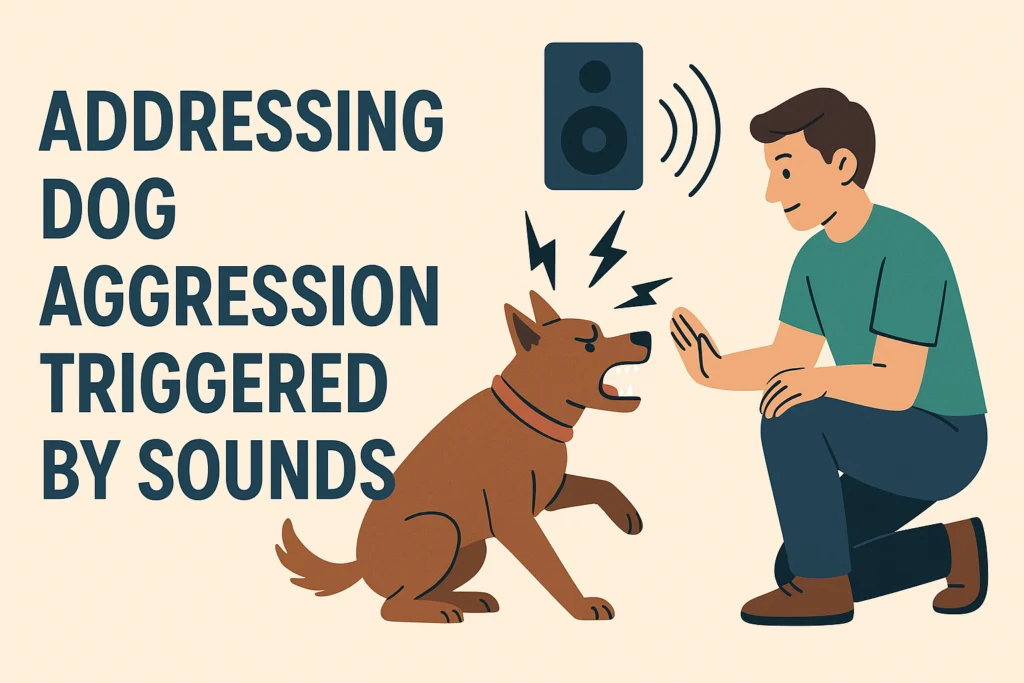Dogs are incredibly intuitive creatures, but their acute senses can sometimes become a source of distress rather than advantage. One of the most misunderstood behaviors in dogs is aggression triggered by specific sounds. This type of aggression can appear suddenly, creating confusion and concern among pet owners.
It might be the roar of a vacuum cleaner, the beeping of a microwave, or even the subtle jingle of keys that sets them off. Understanding and addressing this reaction is essential not only for your dog’s well-being but also for everyone’s safety in your household.
What is Sound-Triggered Aggression?
Sound-Triggered Aggression in Dogs, also known as auditory-induced aggression, is a behavior where a dog exhibits aggressive responses such as growling, barking, lunging, or even biting when exposed to certain sounds. These reactions aren’t just random outbursts; they’re deeply rooted in the dog’s perception of threat, discomfort, or distress. The response can be immediate or build up over time with repeated exposure.
This type of aggression is often misunderstood because it’s not always consistent. For example, your dog might react aggressively to a thunderstorm one day and seem fine during another.
But in most cases, the aggression stems from a negative emotional response — such as fear or anxiety — rather than inherent meanness. The sound acts as a trigger, much like how certain smells or sights can affect people with trauma.
What’s particularly challenging about sound aggression is that it’s involuntary. The dog isn’t “choosing” to misbehave; their reaction is often an instinctual fight-or-flight response.
If flight isn’t an option — say they’re confined indoors — aggression may be the next outlet. That’s why understanding this condition is the first step in helping your dog cope better.
Common Sounds That Trigger Aggressive Behavior
Not all dogs react to the same sounds, but there are common culprits that frequently show up as aggression triggers. Here are some of the most common ones:
- Thunderstorms and fireworks: These unpredictable, loud noises are common triggers due to their sudden onset and volume.
- High-pitched sounds: Sounds like doorbells, phone alarms, or smoke detectors can irritate a dog’s sensitive hearing.
- Household appliances: Vacuum cleaners, blenders, and hairdryers are loud and invasive, often causing anxiety.
- Musical instruments or specific songs: Especially high-frequency tones or sudden loud notes.
- Mechanical or industrial noises: These include garage doors, construction work, or even trucks idling nearby.
Every furry friend is different, so what triggers one may not affect another. The key is identifying which sounds cause your dog distress and when their aggression tends to surface.
This observation forms the basis of any effective treatment or training plan.
The Science Behind Sound Sensitivity in Dogs
Canine Hearing Abilities and Sensitivity
Dogs have extraordinary hearing. They can detect frequencies ranging from 40 Hz to 60,000 Hz, while humans top out at around 20,000 Hz. This means that what sounds like a low hum to you might be a high-pitched screech to your dog. Their ears are built to pick up the softest rustle of a mouse in the grass — a skill that served their ancestors well in the wild.
But this superpower has a downside. Canines are much more susceptible to being startled or distressed by high-frequency or sudden noises. Think about how jarring it would be if someone suddenly blasted a siren in your ear.
That’s how it might feel for your dog when the blender starts.
The auditory canal of a dog also works differently. Sound waves bounce through a more complex tunnel, amplifying certain pitches more than others. If a noise hits that “perfect storm” frequency, it can genuinely hurt. And like any being in pain, a dog might lash out — not to be mean, but because they’re scared or suffering.
Some breeds are more sensitive to sounds due to genetic factors. For instance, herding breeds like Border Collies or Australian Shepherds are hardwired to respond to auditory cues, so they’re naturally more alert — and more reactive — to sound.
Neurological Response to Sound Stimuli
Sound-induced aggression often starts in the brain. The limbic system — the part of the brain that manages emotions — reacts to certain stimuli, including threatening sounds. In sound-aggressive dogs, this system is overactive or hypersensitive. When a triggering sound is heard, the limbic system goes into overdrive, pumping adrenaline and stress hormones through the body. This can cause immediate behavioral shifts from calm to combative.
This isn’t just psychological — it’s physiological. The amygdala, which governs fear and aggression, lights up in response to distressing sounds. It bypasses rational processing and sends the dog into a state of high alert. Over time, this creates a kind of muscle memory: the dog hears the sound, the brain fires off a warning, and the body responds with aggression.
Understanding that this reaction is not a personality flaw but a neurochemical process helps pet parents respond with empathy and strategy rather than frustration or punishment.
Addressing Dogs Aggression Triggered by Sounds
1. Genetic Predisposition and Breed Tendencies
Just like people, dogs inherit traits from their parents. Some breeds are naturally more alert and reactive, especially those bred for guarding or herding. Breeds like German Shepherds, Rottweilers, Dobermans, and even smaller ones like Chihuahuas may have a genetic predisposition toward vigilance and assertive behavior when faced with perceived threats — including sounds.
These genetic factors don’t guarantee aggression, but they can increase the likelihood that a dog will react strongly to environmental stimuli. This is particularly true if the dog isn’t socialized properly during its developmental stages.
2. Past Trauma and Negative Associations
Dogs have remarkable memories, especially for emotionally charged events. If a dog had a traumatic experience associated with a certain sound — like being abused near loud machinery or left alone during a thunderstorm — they may develop a long-lasting negative association with that sound.
These experiences can create a conditioned emotional response. Rescue dogs or those from abusive environments are particularly prone to this, as the aggression often serves as a learned defense mechanism.
3. Lack of Socialization or Training
Canines that aren’t exposed to a wide variety of sights, sounds, and experiences during their critical socialization period (3-14 weeks) may develop sound-triggered aggression. Without proper stress management training, unfamiliar sounds can become overwhelming and provoke fear-based reactions.
Recognizing the Signs of Sounds Aggression in Dogs
Body Language to Watch For
- Raised hackles (piloerection)
- Stiff body posture
- Pinned back ears
- Whale eye (showing whites of eyes)
- Stress signals like lip licking or yawning
Behavioral Escalation Patterns
- Trigger sound detected
- Alertness and scanning
- Muscle tension develops
- Vocalization begins
- Approach/avoidance behavior
- Potential aggression if stressed further
Understanding these canine communication signals helps owners intervene before aggression escalates.
Assessing the Triggers Accurately
Using a Sound Diary to Track Responses
One of the most effective tools in understanding your dog’s aggression patterns is keeping a sound diary. Think of it like a detective’s notebook — it helps you track every instance of a reaction and piece together the puzzle.
| Date | Time | Sound | Dog’s Reaction | Environment | Duration | Follow-up Behavior |
|---|---|---|---|---|---|---|
| 05/15 | 3:30 PM | Vacuum | Growling, hiding under couch | Living Room | 15 mins | Pacing for 30 mins after |
| 05/17 | 9:00 PM | Thunder | Barking, shaking, urinating | Bedroom | 20 mins | Hiding in closet |
This data becomes crucial when working with a veterinary behaviorist or planning a desensitization strategy.
Observing Environment and Context
Context matters — a lot. A sound that causes no issue in one scenario might spark a meltdown in another. This is why it’s essential to assess:
- Was the dog hungry or tired?
- Were there unfamiliar people or pets around?
- Was your dog already anxious from earlier stimuli?
- Did the sound come suddenly or build gradually?
Understanding these canine stress triggers helps create a safer emotional environment where sounds aren’t interpreted as threats.
Techniques for Desensitization and Counterconditioning
The Power of Gradual Exposure
Desensitization is the process of gradually exposing your dog to the triggering sound at low volumes, then slowly increasing the intensity over time. It’s like dipping their toes in the pool before diving in — you help them get used to the water.
Step-by-Step Desensitization Plan:
- Record the triggering sound (e.g., vacuum cleaner noise)
- Play at minimal volume during positive activities
- Reward calm behavior with high-value treats
- Gradually increase volume over weeks
- Maintain consistent sessions
Pro Tip: Use a sound meter app to precisely measure decibel levels.
Counterconditioning to Replace Fear with Positive Associations
This technique changes your dog’s emotional response by pairing the trigger with rewards:
Example Protocol:
- Microwave beeps → immediately give favorite treat
- Doorbell rings → initiate play session
- Thunder rumbles → provide interactive toy
Key Principle: The reward must occur within 1-2 seconds of the sound for effective association.
Behavioral Training and Obedience Reinforcement
Essential commands for sound-sensitive dogs:
| Command | Purpose | Training Tip |
|---|---|---|
| “Focus” | Redirects attention | Start in quiet environment |
| “Place” | Creates safe space | Use non-slip mat |
| “Settle” | Promotes calm | Pair with deep breathing |
| “Leave It” | Prevents fixation | Practice with low-value items first |
Training Progression:
- Master in quiet setting
- Add mild distractions
- Introduce trigger sounds at sub-threshold levels
- Gradually increase difficulty
You May Also Like To Read:
Working with a Certified Trainer or Behaviorist
Sometimes, aggression triggered by sound is too deeply ingrained to manage alone. This is where a professional can make all the difference. Certified dog behaviorists understand the psychological, emotional, and physical layers behind reactive behavior. They don’t just treat symptoms — they find the root cause.
A professional can:
- Conduct a full behavioral assessment
- Create a customized desensitization and counterconditioning plan
- Identify other contributing factors like pain, illness, or sensory disorders
- Teach you how to reinforce desired behaviors consistently
Look for trainers who use positive reinforcement methods rather than punishment-based approaches. Aggression stemming from fear cannot be punished out of a dog — it must be carefully unraveled and replaced with calm, confident responses.
Creating a Safe and Calming Environment
Designing a Sound-Free Retreat Space
Dogs, just like people, need a place where they feel completely safe. A designated calm space can act as your dog’s sanctuary during stressful events. This could be a crate, a specific room, or even a cozy corner blocked off with furniture or baby gates.
To make it effective:
- Use white noise machines or calming music to muffle external sounds.
- Provide plush bedding, favorite toys, and comfort items.
- Keep lighting low and the space quiet.
- Use calming sprays with pheromones like Adaptil.
Train your dog to associate this space with relaxation by occasionally feeding meals there or rewarding calm behavior with treats. Over time, they’ll learn to retreat to this area instead of reacting aggressively when they hear a triggering sound.
Using Calming Tools and Supplements
If your dog’s aggression is severe or escalating, calming aids may help. These aren’t cures, but they can support your training and create a more manageable emotional baseline.
Some effective options include:
- Thundershirts or anxiety wraps: Apply gentle pressure that soothes the nervous system.
- Natural calming chews or CBD treats: Consult with your vet first.
- Aromatherapy diffusers: Lavender and chamomile scents can promote relaxation.
- Prescription anti-anxiety medications: In cases of extreme fear aggression, a vet may prescribe medication to help during the training period.
Always introduce these tools gradually and observe your dog’s response. What calms one dog might not help another, so it often takes some trial and error.
Medical and Health-Related Considerations
Ruling Out Underlying Health Issues
When addressing aggression in dogs, especially when triggered by sound, it’s critical not to overlook medical causes. Sometimes, what appears as behavioral aggression is actually a cry for help. Dogs experiencing pain or discomfort may have a much lower threshold for stress and may react aggressively to seemingly benign sounds.
Common medical conditions that can influence aggression include:
- Ear infections or hearing loss: These make sounds feel more distorted or painful.
- Neurological disorders: Seizures, cognitive dysfunction, or brain tumors can affect perception and behavior.
- Thyroid imbalances: Hypothyroidism, for instance, has been linked to aggression.
- Arthritis or joint pain: Sounds associated with movement or grooming can create anticipation of pain.
- Sensory processing disorders: Some dogs may have heightened sensory sensitivity, similar to autism spectrum conditions in humans.
A full veterinary workup is essential before starting any aggressive behavior modification plan. Blood tests, ear exams, neurological evaluations, and even X-rays may be necessary to rule out health factors. Once medical issues are managed, the behavior often improves — or at least becomes easier to treat.
When to Consult a Veterinary Behaviorist
Veterinary behaviorists are the specialists of the dog world — think of them as psychiatrists for pets. These experts are veterinarians with advanced training in behavior. They’re uniquely qualified to diagnose and treat complex cases of aggression, especially those that might have medical roots.
You should consider consulting a veterinary behaviorist if:
- Your dog’s aggression is escalating rapidly
- You’ve tried training or behavior modification with little success
- Your dog poses a serious risk to other pets or humans
- Medication might be necessary to support treatment
These professionals work hand-in-hand with trainers and general vets to create a well-rounded, safe, and effective plan for recovery. It’s a deeper dive, but for many dogs, it’s the breakthrough they desperately need.
Managing Aggression in Multi-Pet Households
Preventing Aggression Transfer Among Pets
Sound-triggered aggression doesn’t always stay directed at the sound itself. Sometimes, dogs redirect their frustration toward another pet. Imagine hearing an ear-piercing alarm and having no way to stop it — now someone brushes past you. Boom. The frustration explodes on them. This is known as redirected aggression and it’s very real in multi-pet households.
To prevent this, you need to:
- Separate pets when known triggers are likely to occur (e.g., during storms, fireworks).
- Monitor body language closely during stressful moments.
- Train all pets individually and together, reinforcing calmness and boundaries.
- Use gates or crates to create controlled space during trigger times.
Also, don’t punish the dog post-incident. Redirection isn’t malicious — it’s misdirected panic. Focus on creating calm routines and spaces where all pets feel safe, especially during sound events.
Training Other Pets for Harmony
If you have multiple dogs (or cats), each with different thresholds for noise, your training approach needs to be tailored. A sound-aggressive dog needs desensitization, while a non-reactive pet might just need reinforcement for ignoring the sounds and staying calm.
When your aggressive dog sees another pet handling the sound calmly — and receiving praise — it can speed up their learning through modeling. Pairing pets together during low-stress training sessions, while keeping distractions low and rewards high, creates group harmony over time.
Building Long-Term Resilience in Your Dog
Daily Practices to Reduce Reactivity
Long-term success lies in daily habits. You can’t just treat sound aggression during crises. You have to proactively build your dog’s emotional resilience every day. This means reducing their general stress level and teaching them coping skills even outside of triggering moments.
Try these daily strategies:
- Structured exercise: Burn off anxious energy through walks, fetch, or agility.
- Mental stimulation: Puzzle toys, scent games, or basic obedience drills engage the brain.
- Predictable routines: Dogs thrive on structure — mealtimes, walks, play, and rest should follow a loose schedule.
- Regular desensitization practice: Incorporate mild versions of the trigger sound into normal activities.
A relaxed, engaged dog is far less likely to react aggressively when surprised. Think of it like building their “emotional savings account” — so when a withdrawal (stress) happens, it doesn’t overdraw the system.
Celebrating Progress and Staying Patient
Rehabilitating a dog with sound-triggered aggression isn’t an overnight fix. There will be setbacks. Your dog may do fine for weeks, then suddenly react again. That’s okay. It’s not failure — it’s part of the learning curve.
Celebrate the small wins:
- Your dog stayed calm during a low-volume thunder clip.
- They redirected their focus back to you during a firework pop.
- They chose to walk away instead of lunge.
Track these moments. Reward them. Share them with your trainer or vet. Every step forward is a sign your dog is learning to trust you, and trust the world, just a bit more.
When Management is the Best Option
Accepting Limitations and Prioritizing Safety
Not all aggression can be “cured,” especially if it’s deeply rooted in trauma or compounded by age and medical issues. In such cases, management becomes the best and most compassionate choice. This doesn’t mean giving up — it means protecting your dog’s quality of life, and the safety of those around them.
Effective management includes:
- Avoiding exposure to triggering sounds
- Using soundproofing or white noise machines during known stressors
- Muzzling during risky situations (when trained humanely)
- Ensuring your dog always has an escape route
There’s no shame in adapting your environment to your dog’s needs. Think of it like wearing glasses — it doesn’t “fix” your vision, but it helps you function and feel safer. The same logic applies here.
Supporting Your Dog Emotionally and Physically
A dog struggling with sound-triggered aggression often feels misunderstood, afraid, and overwhelmed. They need more than commands and corrections — they need support, trust, and unconditional love.
Support them by:
- Providing consistent, calm energy
- Limiting their exposure to new stressors
- Ensuring regular vet checkups
- Using praise and play as part of daily interaction
- Watching for signs of progress and celebrating them
Dogs are highly adaptive, and many bounce back from emotional scars with the right care. Even if aggression doesn’t disappear completely, a well-managed, well-loved dog can live a joyful, enriched life.
Final Thoughts
Sound-triggered aggression in dogs isn’t about being a “bad” dog — it’s a deeply rooted fear response that demands understanding, patience, and strategic action. From identifying triggers and tracking behavior to using desensitization and professional help, every step taken builds a more confident, resilient dog. While it’s a challenging journey, it’s one that ultimately strengthens the bond between you and your furry companion.
Be their advocate. Be their safety. And most importantly, be their calm in the storm — whether literal or metaphorical. Your consistency, empathy, and commitment are the greatest tools in helping your dog overcome sound-induced aggression.
FAQs
Can sound-triggered aggression be completely cured?
In many cases, sound-triggered aggression can be significantly reduced through consistent training, desensitization, and management, though complete “cure” depends on the dog’s history and severity of the condition.
Are certain dog breeds more prone to sound-triggered aggression?
Yes, breeds like Border Collies, German Shepherds, and Terriers — all known for heightened alertness — can be more sensitive to sounds and more prone to reactive behaviors.
Should I punish my dog for aggressive behavior related to sounds?
No. Punishment can increase fear and anxiety. Positive reinforcement and counterconditioning are more effective and humane approaches.
How long does desensitization training typically take?
It varies greatly — some dogs improve in weeks, others take months. The key is consistency, patience, and progressing at the dog’s pace.
When should I consider medication for my dog?
If your dog’s aggression is severe, persistent, or unresponsive to training, consult a veterinary behaviorist to discuss the possibility of anti-anxiety medications as part of a broader treatment plan.










![Can Dogs Eat Blood? 7 Side Effects [Expert Opinion]](https://petskor.com/wp-content/uploads/2022/04/Webp.net-resizeimage-12.jpg)
